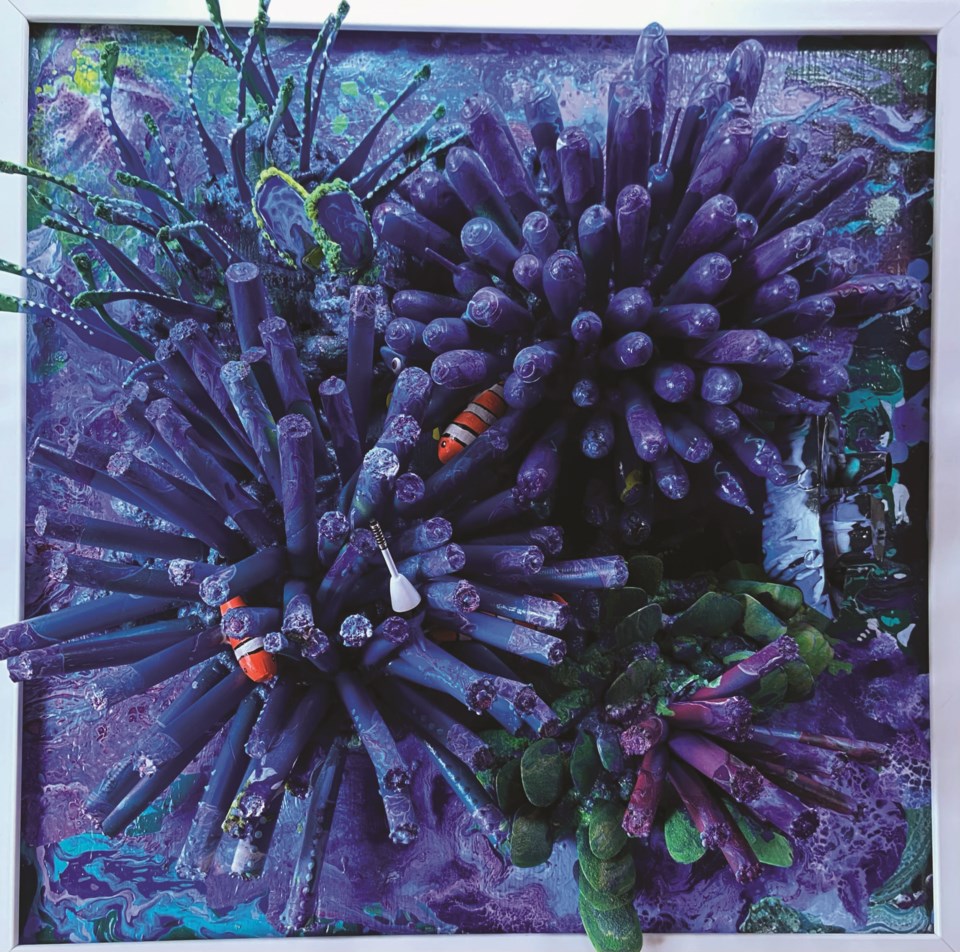Arne Gutmann is good with trash. Or rather, he’s accustomed to taking objects that others ignore or deem ugly, and turning them into something beautiful. The longtime Whistler artist—who recently relocated to Powell River—of poo font fame (Google it) once created an entire art show out of the hair strands haphazardly left behind on the shower wall by his wife. So when the organizers of Diving In: The Art of Cleaning Lakes and Oceans approached him to create a piece made from trash recovered from B.C. lakes and oceans, he jumped at the chance.
“I was like, ‘Good, garbage is my middle name,’” Gutmann told Pique in an interview last month.
Gutmann is one of three Whistler artists, alongside Paulo and Cary Campbell Lopes, the husband-and-wife team behind the whimsical specialty costume and bodypainting company, Paintertainment, who took part in the B.C.-wide environmental art campaign.
Run in collaboration with the Sea to Sky Arts Council Alliance, the collective has partnered with the volunteer-led Divers for Cleaner Lakes and Oceans, which, since it began in 2013, has collected approximately 35,000 pounds of trash from B.C.’s waters—including right here in Whistler.
Each artist is given a large coffee sack full of trash, from which they are asked to create a piece, with the only instructions being that the work has to be able to transport easily enough from the various galleries showcasing the art, as well as come with a list of instructions in the event the piece begins to fall apart.
The creative exercise came with its own challenges for the Lopes’—although given the low budgets and often structural nature of the work they do through Paintertainment, it was not an altogether unfamiliar process for the couple.
“I’m a collector of all sorts of things, whether it’s stuff from dollar stores, or I often find things or take apart things. With most of the jobs we have for the entertainment industry, our budgets are not massive in the way that we can spend a lot on the products and the costume pieces that we use, so we do try to reuse, recycle and repurpose anything we possibly can,” explains Cary. “Also, for cost reasons, my costumes are a lot of structures and pieces we have to develop. They’re not always made from fabric, so it is more of a crafty thing.”
Because the couple each got a bag of trash, they were able to share found items and choose what worked best for their specific piece. Cary gravitated to the neon-tipped fish floats she received to create a work reminiscent of both the deep sea and the beloved Pixar film, Finding Nemo.
“It was really trying to create a beautiful image of what’s really under there and what we do want to protect by using all the pieces that we have. I used the sunglass pieces as a coral structure on one side of it, and then after creating that whole thing and doing a lot of painting of more underwater, sea paint as my background, I actually came across one item that was not found in the trash bag,” she says.
That item? A dollar-store toy Dory, the perfect addition to her orange-hued Nemos already accenting the piece. “The colouring was so perfect, so he’s actually in there as my Dory, and there are two or three little Nemos,” Cary adds.
Paulo’s bag, meanwhile, was overflowing with aluminum beer cans and alcohol bottles, which reminded him of the rum-soaked pirates that used to terrorize the open seas. His piece resembles the classic skull-and-crossbones flag—except without the crossbones. The skull is made up of the cans, while discarded paddle heads make up the eyes and nose. The difficult part was figuring out a way to affix the cans to a wooden frame so they wouldn’t fall off, which Paulo eventually achieved by incorporating chicken wire.
Although the process was admittedly a fun challenge, Paulo says it was deflating to see the volume of waste that was plucked from our waters.
“There were alcohol beverage tins and everything, and that’s sad because that’s literally just someone dumping them in there. That’s not a mistake. It’s careless,” he says.
Gutmann’s piece was also heavy on cans, which he weaved together to create the shimmering effect of a waterfall. Like the Lopes’, the hardest part wasn’t the creative process, but the actual cleaning and assembly of the discarded materials.
“I was pleased,” he said. “I only got one good cut and one puncture.”
Diving In: The Art of Cleaning Lakes and Oceans comes to Whistler from June 1 to 29 at the Maury Young Arts Centre gallery. Admission is free.
Learn more at divinginbc.com.





